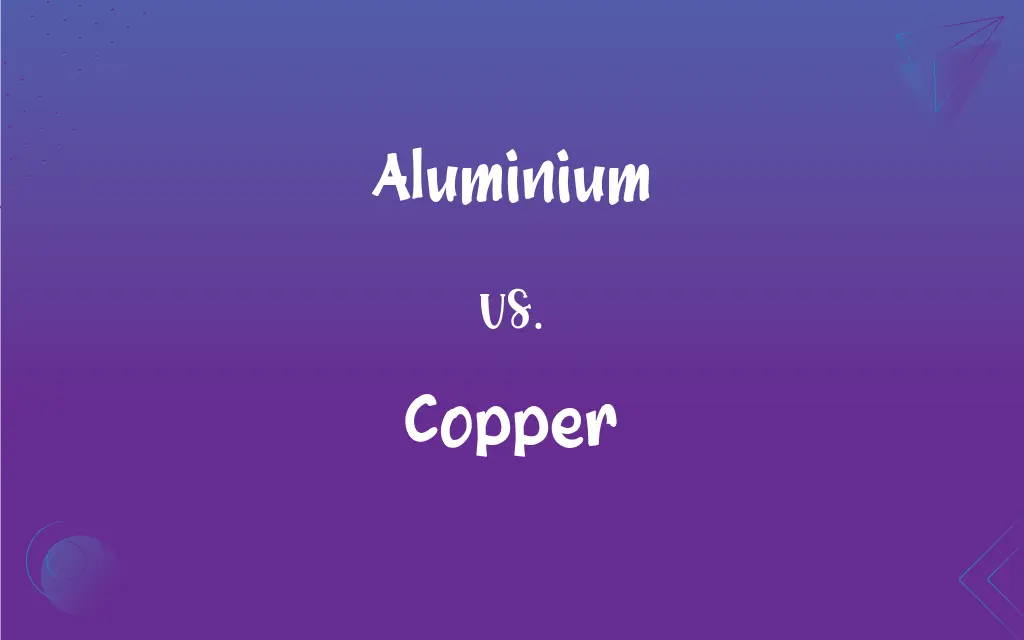Aluminium vs. Copper: What's the Difference?
Edited by Aimie Carlson || By Janet White || Published on January 14, 2024
Aluminium is a lightweight, silvery metal with high corrosion resistance. Copper is a reddish-brown metal known for its high thermal and electrical conductivity.

Key Differences
Aluminium is a lightweight metal, making it ideal for applications where weight is a concern, such as in aerospace. In contrast, copper is heavier but excels in electrical conductivity, making it a primary choice for electrical wiring.
Aluminium has a lower electrical conductivity compared to copper, but its resistance to corrosion makes it valuable for outdoor or marine environments. Copper, while highly conductive, is more prone to oxidation, leading to issues like corrosion over time.
In terms of cost, aluminium is generally cheaper and more abundant than copper, making it a more economical choice for large-scale applications. Copper, on the other hand, is more expensive due to its superior conductivity and other properties.
Aluminium is notable for its ability to form strong lightweight alloys with other metals, broadening its range of applications. Copper is less frequently alloyed, as it's often valued more for its pure form's properties, especially in electrical and thermal applications.
Regarding thermal conductivity, aluminium conducts heat well, but not as efficiently as copper, which is one of the best conductors of heat. This makes copper an ideal material for heat exchangers and cookware.
ADVERTISEMENT
Comparison Chart
Weight
Lightweight
Heavier
Electrical Conductivity
Lower than copper
Very high
Corrosion Resistance
High
Less, prone to oxidation
Cost and Abundance
Cheaper, more abundant
More expensive, less abundant
Thermal Conductivity
Good
Excellent
ADVERTISEMENT
Aluminium and Copper Definitions
Aluminium
A lightweight, silvery-white metal with high corrosion resistance.
Aluminium is widely used in aircraft manufacturing due to its lightness.
Copper
A reddish-brown metal known for excellent electrical and thermal conductivity.
Copper wiring is essential in the electrical industry for its conductivity.
Aluminium
A ductile metal used in a wide range of industries, from aerospace to packaging.
Aluminium cans are popular for packaging beverages.
Copper
Element 29 on the periodic table, a transition metal with high malleability.
Copper is a versatile element used in a wide range of industries.
Aluminium
A metal known for forming alloys with various properties for different applications.
Aluminium alloys are essential in the construction of modern skyscrapers.
Copper
A ductile metal that has been used since ancient times for various applications.
Copper has been used to make coins and jewelry for thousands of years.
Aluminium
A metal used in electrical transmission lines due to its low density.
Aluminium is often used in power lines for its lightweight and conductivity properties.
Copper
A metal often used in plumbing and heating systems due to its thermal properties.
Copper pipes are a common choice for plumbing because they're durable and resist corrosion.
Aluminium
Element 13 on the periodic table, a post-transition metal.
Aluminium, though abundant in the earth's crust, is always found combined with other elements.
Copper
A naturally occurring element that can be found in the earth's crust and in the human body.
Copper is essential for the human body, playing a role in the formation of red blood cells.
Aluminium
Variant of aluminum.
Copper
Symbol Cu A ductile, malleable, reddish-brown metallic element that is an excellent conductor of heat and electricity and is widely used for electrical wiring, water piping, and corrosion-resistant parts, either pure or in alloys such as brass and bronze. Atomic number 29; atomic weight 63.546; melting point 1,085°C; boiling point 2,562°C; specific gravity 8.96; valence 1, 2. See Periodic Table.
Aluminium
A light, silvery metal extracted from bauxite, and a chemical element (symbol Al) with an atomic number of 13.
Copper
A coin, usually of small denomination, made of copper or a copper alloy.
Aluminium
(countable) A single atom of this element.
Aluminium
(slang) Aircraft or other machinery made partially or wholly of aluminium.
Aluminium
Same as aluminum, chiefly British in usage.
Aluminium
A silvery ductile metallic element found primarily in bauxite
FAQs
What is copper?
A reddish-brown metal with high electrical and thermal conductivity.
What are the main uses of copper?
Electrical wiring, plumbing, and heat exchangers.
Why is aluminium used in aircraft?
Due to its lightness and strength.
Does copper corrode easily?
It oxidizes but forms a protective layer that prevents further corrosion.
What is aluminium?
A lightweight, corrosion-resistant metal.
Is copper expensive?
It's more expensive than aluminium.
Can aluminium be alloyed?
Yes, it's often alloyed to enhance its properties.
Is aluminium a good conductor of electricity?
Yes, but not as good as copper.
Is copper magnetic?
No, it's non-magnetic.
How is copper mined?
Through open-pit mining and underground mining.
What are aluminium alloys used for?
In construction, transportation, and aerospace.
What are the environmental impacts of aluminium production?
It's energy-intensive and can impact local environments.
Does aluminium react with food?
It can, so it's often coated or anodized for cookware.
Are aluminium cans recyclable?
Yes, they are highly recyclable.
What colors does copper form through oxidation?
It forms a greenish patina.
Why is copper used in electrical components?
For its superior electrical conductivity.
Is aluminium found in the human body?
Only in very small amounts, not essential for life.
How is aluminium extracted?
Mainly from the ore bauxite.
Can copper be recycled?
Yes, it's highly recyclable.
Is copper used in cookware?
Yes, for its excellent heat conductivity.
About Author
Written by
Janet WhiteJanet White has been an esteemed writer and blogger for Difference Wiki. Holding a Master's degree in Science and Medical Journalism from the prestigious Boston University, she has consistently demonstrated her expertise and passion for her field. When she's not immersed in her work, Janet relishes her time exercising, delving into a good book, and cherishing moments with friends and family.
Edited by
Aimie CarlsonAimie Carlson, holding a master's degree in English literature, is a fervent English language enthusiast. She lends her writing talents to Difference Wiki, a prominent website that specializes in comparisons, offering readers insightful analyses that both captivate and inform.






































































